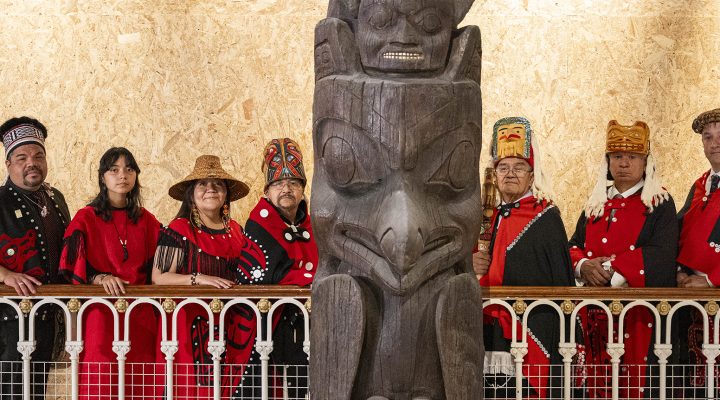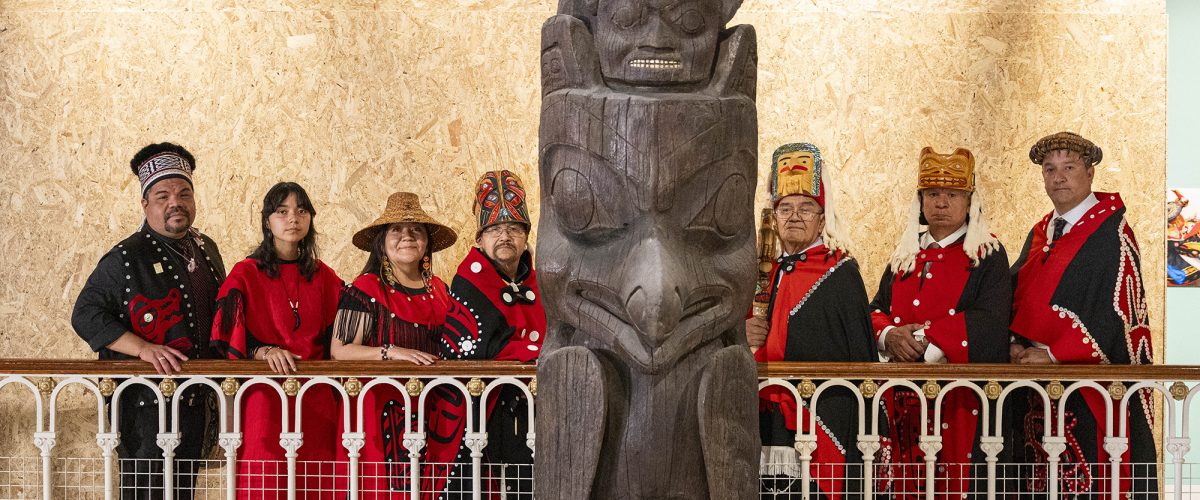After nearly 100 years in captivity, a long-lost member of Nisga’a Nation in northern British Columbia, Canada, is finally heading home.
The House of Ni’isjoohl Pole, a 36-foot-tall totem pole carved from a red cedar tree, has been on display at the National Museum of Scotland since 1929. Recently, a delegation of tribal members, led by Chief Earl Stephens, visited Edinburgh and conducted a private, spiritual ceremony to prepare the totem pole for the journey ahead.
“In Nisga’a culture, we believe this pole is alive with the spirit of our ancestors” said Chief Stephens, called Sim’oogit Ni’isjoohl in the Nisga’a language. “We are finally able to bring our dear relative home to rest on Nisga’a lands.”

Jodi Spargur
Jodi Spargur of Red Clover Initiatives and Canadian Baptist Ministries explained the significance of the pole’s return to British Columbia: “What you’re responsible for is the land, and where Creator speaks to you is through the land, and the way you bear witness to where Creator shows up is through telling the stories through totem, but all of that is meant to be on the land. So, the idea of displacing it from the land isn’t so much about animism, it’s about everything being in relationship.”
The notion that indigenous people practice, or ever practiced, animism is a common misperception based on linguistic differences.
The notion that indigenous people practice, or ever practiced, animism is a common misperception based on linguistic differences, Spargur said.
The return of the Nisga’a totem pole is the first time a major British museum has repatriated such an artifact to any of North America’s indigenous people. In 2021, National Museums Scotland changed its policy regarding repatriation to better conform to the 2007 United Nations Declaration on the Rights of Indigenous Peoples, which calls on governments and organizations to “enable the access and/or repatriation of ceremonial objects … through fair, transparent and effective mechanisms developed in conjunction with indigenous peoples concerned.”
The research and advocacy of Amy Parent (Sigidimnak’ Noxs Ts’aawi) of Simon Fraser University in British Columbia has paved the way for the return of the pole to the Nisga’a people. She calls the agreement “a very historic moment for our nation and for Scotland.”
A second attempt
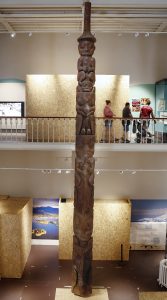
A view of the 36-foot totem pole now on its way from the National Museum of Scotland to British Columbia on the west coast of Canada. (Photo by Jeff J Mitchell/Getty Images)
Two decades ago, another Nisga’a delegation to Scotland attempted to retrieve the totem, but their efforts were rebuffed by officials who claimed the pole was too old to be moved. With the positive change in the NMS repatriation policy, and news that the museum was able to safely move the pole during a recent renovation, Parent determined it was time to try again. She and other Nisga’a representatives met with museum and government officials to negotiate the return of the pole.
Angus Robertson, Scotland’s culture minister, welcomes the decision to return the pole to its place of origin. “It follows a deeply moving recent meeting with the Nisga’a delegation when they came to Scotland to explain the huge importance of the pole to their culture, people and community,” he said.
Canadian experts assessed the pole’s condition and confirmed it would be possible to move it safely.
“To prepare the pole to be able to leave the building, we first needed to clear out entire galleries,” said John Giblin, keeper of global arts, culture and design at the National Museum of Scotland. The museum is erecting scaffolding around the Nisga’a pole and plans to maneuver it out a window before transporting it to a local air base. There, a military plane from the Royal Canadian Air Force will fly the totem pole across the Atlantic.
The NMS originally intended to move the pole via ship but Parent thought flying the pole home would reduce the risk of damage.
Welcome celebration
The Nisga’a community is planning a celebration to welcome home the Ni’isjoohl pole this Saturday, Sept. 29. More than a thousand people are expected to attend.
Hli Goothl Wilp-Adokshl Nisga’a (“Heart of Nisga’a House Crests”), a museum dedicated to the Nisga’a people, will house the repatriated totem pole. The museum opened in 2011 as the result of a treaty signed in 2000 between the Nisga’a and the governments of Canada and British Columbia. Along with the rights to self-government and ancestral land, the treaty also included provisions for the return of ancestral possessions housed in Canadian museums. So far, more than 300 objects have been returned to the community and, with the Ni’isjoohl pole, the Nisga’a Museum has expanded its search internationally.

Amy Parent
“Within the pole itself we have crests — often represented by animals or humans — and within our particular pole there are two carved ravens as well as some other animals and then the chief sitting at the top,” Parent said. Originally the pole stood on the banks of the Nass River in the Nisga’a village of Ank’idaa, upriver from modern-day Laxgalts’ap.
The origin story
Joanna Moody, Parent’s ancestor, commissioned master carver Oyay Tait and his assistant, Gwanes, to carve the House of Ni’isjoohl pole in the 1860s. The pole tells the story of Ts’wawit, a warrior who would have been chief, but sadly perished protecting Nisga’a Nation.
In 1929, Marius Barbeau, an ethnographer and curator at the National Museum of Canada, came upon the totem pole when scouting the Nass Valley in search of artifacts to sell.
“He would take a photo of a pole,” Parent explained, “and then on the back, he’d write a price and shop (the poles) to museums around the world.” Museum staff in Scotland selected the pole from Barbeau’s catalog and hired him to acquire it for the cost of $400 to $600 Canadian dollars, with another $100 for transportation.
Barneau and his assistants cut down the totem pole from its position outside the house of Ts’wawit’s family during the summer while the Nisga’a were away for the annual hunting and harvesting season. He then floated the Ni’isjoohl pole along with several other poles and artifacts down the Nass River on rafts while, according to Nisga’a chief William Moore (Sim’oogit Duuk), nearby villagers gathered on the river bank and watched their heritage drift away with the current.
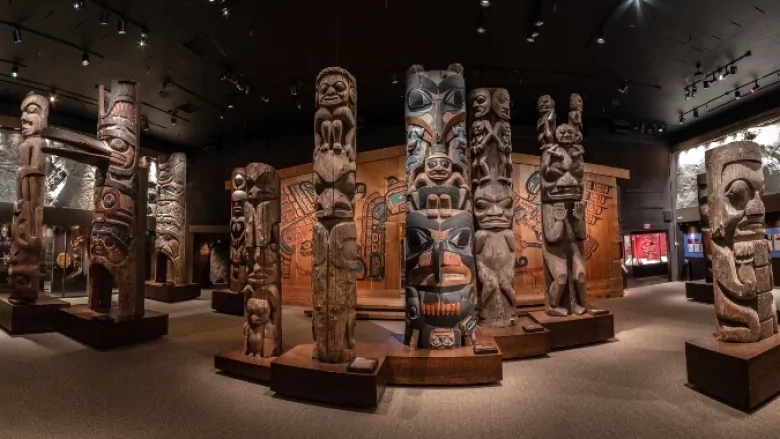
First Peoples Gallery, Royal B.C. Museum. (Royal B.C. Museum)
The missionary connection
The story of the Nisga’a totem pole is tragic and unfortunately not unique. In 1932, Barneau returned to the Nass Valley and acquired another Nisga’a totem pole, this time for the British Museum in London.
The ancestral possessions of indigenous people from all over the globe fill the galleries of museums like these throughout Europe and North America. Their presence is so ubiquitous most museum goers have given little thought to how artifacts from Ethiopia ended up in Edinburgh, or objects from Lusaka arrived in London. Often the answer is: Under the auspices of Christian missionaries.
By 1814, when the London Missionary Society rented a “set of rooms near the Old Jewry in Cheapside,” they already had amassed a substantial collection of “curiosities” donated by missionaries serving in Asia and Africa. Twice a week members and friends of the LMS could visit the Missionary Museum and see objects from life overseas along with a menagerie of exotic taxidermized animals including, according to one visitor, “a very fine cameleopard” (giraffe).
The arrival in 1818 of a set of “family idols” from Tahiti ignited an artifact arms race among the organization’s missionaries. Each hurried to bring home evidence of his “success” on the mission field in the form of discarded deities.
How these sacred items ended up in the hands of the missionaries is not always clear.
How these sacred items ended up in the hands of the missionaries is not always clear. When native people made new carvings, they threw the old ones away or gave them to the missionaries who had been attempting to confiscate them. Sometimes missionaries purchased sacred figures directly from indigenous groups. However, in these cases, where the power dynamics were so uneven, it’s difficult to determine how willing the natives were to sell.
The LMS began publishing a quarterly magazine, Missionary Sketches, that featured illustrations of its donations, such as “22 models of Hindoo deities” with commentary by Baptist missionary Rev. Mr. Ward, a colleague of William Carey. Its circulation, along with tours of the “idols” to various missionary festivals, increased donations to the society.
One attendee to such a festival in Cornwall wrote, “Surely, they are fit to represent the hatefulness of devils and correspond well with the shocking rites of devil worship. Who that has a heart to feel can refrain from rejoicing that the mercy of God has rescued a portion of the human race from the horrors of such an idolatry! And who that has a mite to bestow would grudge to give it for a purpose so noble?”
As the British empire expanded over the next century, so did its compulsion to exhibit the spoils ofmcolonialism. The Missionary Museum, once the only place to see exotic objects from around the globe, no longer could keep up with its London neighbor, the burgeoning British Museum. In 1910 the LMS closed its doors and sold 836 objects to its rival, including a wooden figure from the Cook Islands, a charm for childless women in Botswana, and a mask from Papua New Guinea. The rest of its collection was bought by similar, smaller ethnographic museums like the Pitt Rivers Museum in Oxford.
Yet, the end of the Missionary Museum did not mean the end of involvement by missionaries and mission societies in acquiring indigenous artifacts.
Often missionaries were the first non-native persons to enter indigenous spaces, and where they went colonial governments were quick to follow.
Often missionaries were the first non-native persons to enter indigenous spaces, and where they went colonial governments were quick to follow. In the case of the totem poles of British Columbia, Christian missionaries erroneously believed the First Nations people of that area were worshipping the poles as pagan idols. They pressured native tribes to stop carving and erecting totem poles and to tear down existing ones.
In some cases, missionaries may have set fire to this sacred art. “Within the Nisga’a context, missionaries evangelically invaded the Nass Valley and, for the most part, forced us to let go of our priceless cultural family belongings and possessions,” Parent and Moore wrote in their book, Scotland’s Transnational Heritage: Legacies of Empire and Slavery.
In 1900, the Pit Rivers Museum in Oxford was seeking a totem pole for its growing indigenous collection. A missionary to the Haida people, Charles Harrison, had collected 142 native objects for the museum and was collaborating with the museum’s curator, E.B. Tylor, in hopes of finding a pole for the Pitt Rivers. Tylor was concerned about missionary influence reducing the overall number of available totem poles.
Harrison confirmed his fears and said in a letter, “Totems are getting very scarce as the people are not now in the habit of erecting them, and in the near future will all be gone, so now the time is ripe for national and private museums to obtain them.”
Harrison also said he was counting on winter hunger and desperation compelling the Haida to finally sell him their remaining totem poles.
Language and culture outlawed
Pressured by the church and civil servants, the Canadian government amended the Indian Act in 1884 to outlaw native languages, culture, governance and art. For tribes in British Columbia, this included the banning of totem poles and the potlatch ceremonies that often accompanied them. A potlatch is a First Nations celebration marking a special occasion such as a birth, death or the appointment of a new chief. It often includes singing, dancing and storytelling, with the performers donning elaborate masks to dramatize the stories. The potlatch host distributes gifts to attendees to thank them for witnessing the event.
“The Indian agent who would have been the one negotiating any sales and enforcing any restriction on potlatch was actually the Anglican minister as well.”
According to Spargur, “In Nisga’a territory in the 1850s to the 1890s, the Indian agent who would have been the one negotiating any sales and enforcing any restriction on potlatch was actually the Anglican minister as well.”
When citizens of ʼNa̱mǥis First Nation of Alert Bay held a lavish potlatch in 1921, the Royal Canadian Mounted Police seized the people’s ceremonial objects and later their totem poles. They arrested 45 participants but agreed to suspend their sentences in exchange for native masks, regalia and other ancestral possessions. These they gathered together in a local church and then sold to eager collectors and museum curators. A carved wooden transformation mask from this potlatch is now in the possession of the British Museum.
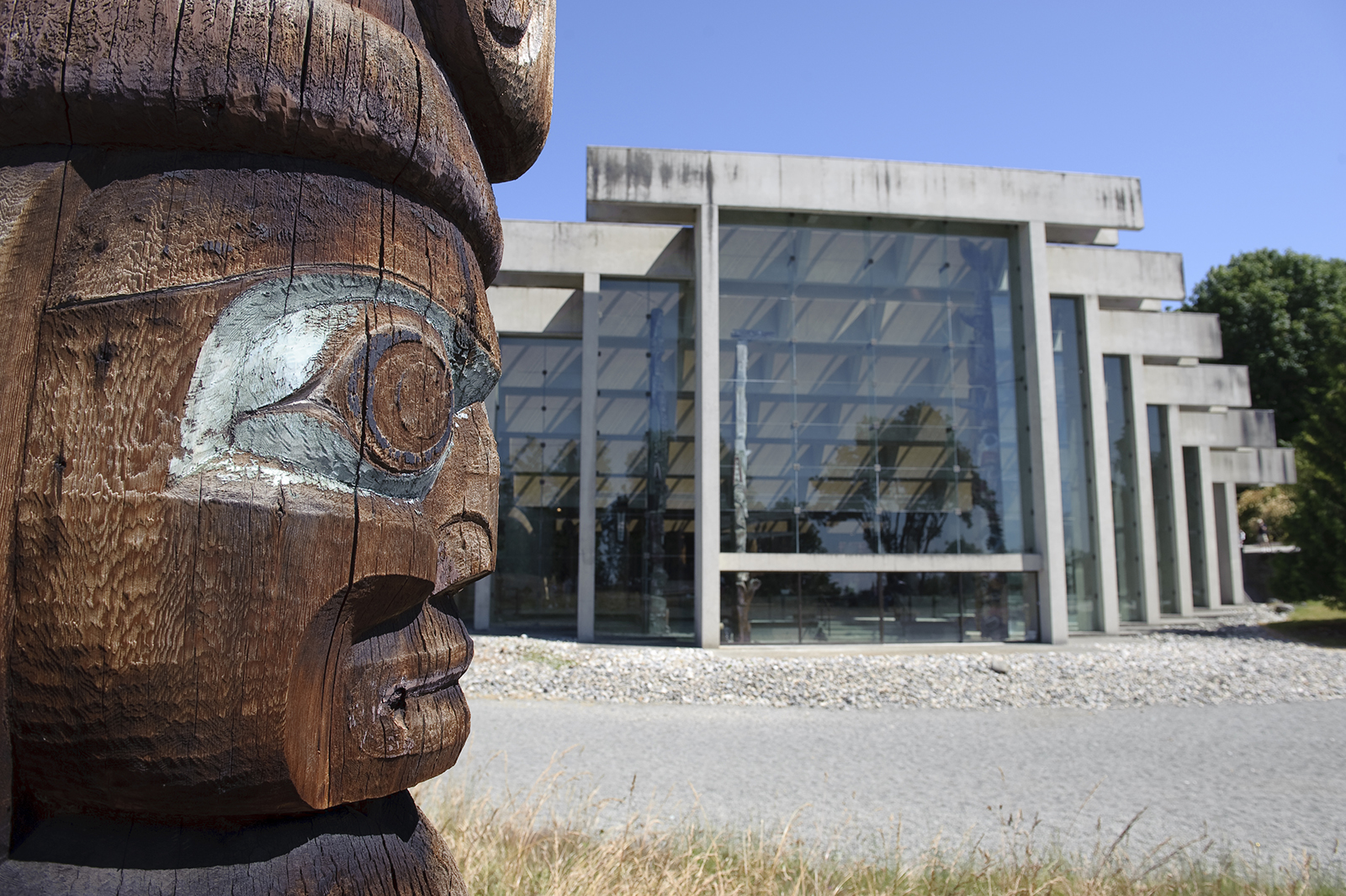
A carved totem outside of the University of British Columbia’s museum of Anthropology, designed by architect Arthur Erickson. The museum is home to a vast collection of pacific coast native art, including Haida, Gitxsan, Nisga’a, Oweekeno and other First Nations art. (Photo by Christopher Morris/Corbis via Getty Images)
Will others also repatriate?
Will any of these other museums follow the lead of the National Museum of Scotland and repatriate the indigenous items from their collections? The United Kingdom passed a law in 1963, the British Museum Act, which forbids that institution from returning objects unless they are duplicates, damaged, unfit to be kept or no longer of interest to the public. Parliament’s original intent was to prevent politicians from disposing of items on a whim or as a way to score political points. However, museum trustees and government officials invoked the law to avoid returning pieces looted or coerced from native peoples.
What makes this use of the British Museum Act particularly heartbreaking is that so many of these stolen items are not even on display at the museum. They languish in the depths of its vast archives and underground storage facilities.
Out of its total collection of 8 million objects, only 1% (80,000) are currently on display. (Another 4,000 items are on loan to other institutions).
The London Missionary Society’s Papua New Guinea mask and Botswana charm sit forsaken on a shelf somewhere in the maze of boxes. An African ceremonial axe, wooden mask, and feathered headdress, donated by the Baptist Missionary Society, are perhaps stored nearby.
It is difficult to argue these items are enriching the public when the public can’t see them.
It is difficult to argue these items are enriching the public when the public can’t see them. If museum trustees returned such artifacts to their indigenous owners, no doubt those communities would treasure them and give them pride of place in their own museums or incorporate them into public ceremonies and celebrations.
The British Museum has made some exceptions to its 1963 rule. In 2004, the Human Tissues Act allowed museum trustees to return human remains, and in 2009 the Holocaust Act permitted the repatriation of artwork stolen by Nazis during the Second World War. The recent passage of the 2022 Charities Act includes a provision for museums to return objects from their collections if their trustees feel a “moral obligation” to do so. However, permission from the UK courts, Charity Commission or attorney general is still required if the item is of “high value.”
At the moment, the entire repatriation portion of the Charity Act is on hold pending review by the House of Lords. It may ultimately require an ouster of the Tory party in 2025 before any museum artifact follows the Nisga’a pole on its journey home.
Colonizer perspective
Another major stumbling block toward repatriation is the colonizer perspective that pervades North American and European museums. In a speech to British Museum trustees, chair George Osborne said, “How could a collection of this scale and scope have come together without controversy or conflict? That is part of our human story.”
Osborne’s assertion assumes all humans engage in brutal colonialism and excuses the actions of Britain’s past as little more than imperial growing pains. Too often institutions like the British Museum center the experience of straight, white Europeans and, as a result, define “world culture” as “opponents of the British Empire,” according to Dan Hicks, a curator at Oxford’s Pitt Rivers Museum. Perhaps museums like the National Museum of Scotland, the Pitt Rivers in Oxford, and the British Museum maintain these collections from their colonial pasts as a means of clinging to that past identity as a colonizing power and cultural force.
Colonialism banned indigenous culture while at the same time claiming its museums were the only places willing and able to preserve that culture.
A 1903 article about the British Museum’s new totem pole claims there is a “decline, in native estimation, of the importance of these totemic columns” with no mention that the Canadian government had outlawed their creation. Colonialism banned indigenous culture while at the same time claiming its museums were the only places willing and able to preserve that culture. Many museums today make similar assertions. They disparage the ability of non-Western and indigenous communities to properly appreciate and care for their own ancestral artifacts.
“Anti-racism in museums isn’t about pretending colonialism never happened,” Hicks said. “It begins with not pretending any longer that colonialism and its consequences are wholly in the past.”
Although progress is slow, some museums in the United Kingdom are making efforts toward healing their relationships with indigenous tribes. The British Museum is circumventing the 1963 British Museum Act by loaning items in its collection to indigenous museums and cultural centers with the option to renew the loans every three years. That wooden transformation mask seized in the 1921 Alert Bay potlatch is currently on long-term loan to the U’mista Cultural Centre at Alert Bay, British Columbia, as part of its potlatch exhibit.
Oxford’s Pitt Rivers Museum has partnered with Haida Nation curators, artists and scholars to share access to the museum’s artifacts from Haida Gwaii, including its Star House totem pole. In 2009, a delegation of 21 Haida citizens spent several weeks in Oxford sharing their knowledge with museum staff, giving weaving and carving demonstrations and reconnecting with their ancestral possessions. Two Haida carvers again visited the museum in 2015 and created an exact replica of a Haida box in the museum’s collection. Now high school classes in Haida Gwaii use the box to teach traditional Haida art to students.
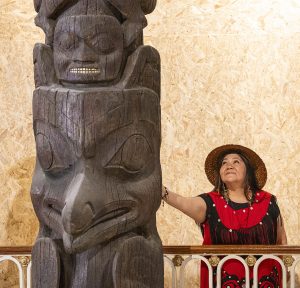
Pamela Brown of the Nisga’a Nation with the Ni’isjoohl Memorial Pole. (Photo by Duncan McGlynn/National Museums Scotland)
Back in Edinburgh, at the National Museum of Scotland, curators hope to replace the Ni’isjoohl pole with artwork and other items that will introduce visitors to Nisga’a culture. “We hope (the return of the pole) is not the end of the process but the next step in a fruitful and ongoing relationship with the Nisga’a,” said museum director Chris Breward.
A continued relationship also would be in line with the way native cultures understand the impact of possessing an object. “There would also be this sense of, ‘You had this in your possession in Scotland,’ so communities may say, ‘We still have a relationship with you, because this was in your possession and shaped you’,” Spargur said. “If Scotland and the Nisga’a have this ongoing relationship, what a beautiful thing.”
Perhaps the National Museum of Scotland could commission contemporary Nisga’a artists to carve a new pole for their gallery. All too often the presence of native artifacts in ethnographic museums perpetuates the idea that the cultures behind those objects are extinct. However, showcasing new artwork by First Nations artists and craft persons pushes back against this colonial narrative and reminds museum visitors the Nisga’a are still a living, vibrant community. Providing the indigenous community a platform within the museum also helps to decentralize European voices and allows indigenous people to tell their own stories.
Amy Parent hopes the story of the repatriation of the Nisga’a pole inspires other indigenous communities.
“We see this as one large step forward for our family and our nation’s repatriation journey, but one small step for all the reconciliation work that’s still required of all museums with imperial and colonial legacies,” she said. “They need to continue enacting their commitments to us as indigenous peoples. Justice for our ancestors will prevail.”

